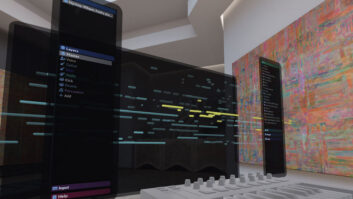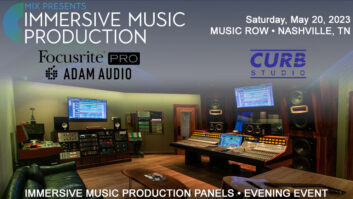Wantagh, NY (September 19, 2018)—When Rob Zombie and Marilyn Manson joined forces this past summer for a co-headlining tour, it was a good show—but it was still evil. The Twins of Evil: The Second Coming Tour hit the sheds for 29 shows in July and August, with a house system and Zombie’s control gear provided by Clair Global, while Manson’s was provided by Battlestar Productions. With the exception of monitor engineer Jay Summers, Zombie’s entire sound crew came directly from a run with Poison, and included production manager/front of house engineer Mark Woodcock, crew chief/assistant FOH engineer Norm Stallings and PA techs Nathan Lowe and Jacob Caples.
The closeness and consistency of the team made for a steady and enjoyable work flow for everyone involved, according to Woodcock. “I left the Poison tour in Florida,” he said, “and Norm finished the last two shows as FOH while I flew to L.A. to catch rehearsals for the Twins of Evil tour.” The rest of the crew joined pre-production soon after. It wasn’t Woodcock’s first run with Zombie either—he’s spent a decade as the artist’s production manager and three years as the FOH engineer, adding to a mix resume that includes the likes of Merle Haggard, Bush, Babyface, Cindy Lauper and Richie Sambora, among others.
For the run, Woodcock and Summers each used Yamaha’s new Rivage PM7 consoles, marking their first times out with the desk. “I went out to Clair in Lititz, PA to visit Mike Adams last year and I ran into Toby Francis (FOH for Katy Perry, Arianna Grande, Kiss). He suggested I play around with the Yamaha Rivage PM10 and said, ‘It’s really worth a listen.’” After trying it out, Woodcock immediately took the PM10 out with a cappella group Pentatonix: “I liked the work flow and how it sounded, so then I then tried it with a full band on a five-week tour with Bush and I was convinced it sounded great.”
For the Zombie summer tour, he transitioned to the PM7—essentially the same desk with fewer inputs and outputs. “Back at the beginning of the year, they asked if I would want to take the PM7 out, as they had just got a bunch in,” Woodcock explained. “In the PM7, I like having the DSP in the desk and not being external; it saves on space. The PM7 does have the PM10 rack, though, so you get the Rupert Neve inputs.”
On monitors for the tour was J. Summers, taking the place of long-time Zombie monitor man Steve Walsh who was committed to a summer tour with Luis Miguel. Summers trained on the PM7 at Clair’s Lititz facility prior to the tour. “Steve sent me his PM5D file to convert for the Rivage,” he recalled. “We met for the first time in L.A. at rehearsals to develop the mixes that Rob and the Band required. Steve’s trust and solid foundation with these guys set me on course for a great summer, so thank you, Steve!”

Zombie’s FOH mix was straightforward as well. “With Zombie, there are not a lot of dynamics,” said Woodcock. “Poison has acoustic songs and ballads, while Zombie is a straight in-your-face rock show—loud and proud.” One of the key ingredients every night was the artist’s signature vocal sound. “Rob’s vocal is different than most acts—it’s pure effect,” he noted. “There’s no dry vocal at all. It’s an Eventide [preset] 519 MicroPitch shift that he uses throughout the whole show. It’s not an outboard effect; it’s now part of the plug-ins on the PM desks.” Additionally, Woodcock made use of onboard offerings, including a Rupert Neve Designs Portico 5043 compressor.
Onstage, what the band heard was just as important. “Rob’s vocal is purely effected returns,” Summers noted. “There is no dry ‘Rob vocal’ on stage—he requires two SPX pre-sets, tailored, of course. They give him the demonic sound that he digs; it totally sets the vibe.”
If Zombie’s vibe was eerie, the crew’s vibe was efficient. Crew chief Norm Stallings explained, “Normally our load-in starts at 8 AM and I have the PA tuned by noon. Mark is ready to do a line check, provided backline is up and ready. In all honesty, it’s pretty easy. As for the load outs, all my stuff is in the truck in about an hour-fifteen, including the motors.”
When Pro Sound News caught up with the tour at the Northwell Health at Jones Beach Amphitheater, however, the set up was different by necessity. Stallings explained, “Jones Beach is a complete caveat to almost everything we normally do. Everything has to enter the deck from stage right, so that means nothing gets flown on that side until the end.”
For the Zombie/Manson tour, Clair Global provided its proprietary Cohesion series loudspeakers—which meant the audio team used the same loudspeaker arrangement as it had just weeks earlier at the same venue for Poison. The stage left-right hangs each sported a dozen CO-12s to cover the grandstand down to the pit, with the bottom four boxes set at 120 degrees and the top eight at 80 degrees. All that was supported by Cohesion CP-218 sub enclosures. “The subs are eight aside and I have them all fired forward,” said Stallings. “I’ve steered them 180 degrees per array so it gets rid of a power alley, and I find there is really good sub-bass coverage even up to the upper deck grandstands.”
Additional side hangs of eight Cohesion CO-10s each were used nightly, aimed differently depending on the venue, to provide complete sound coverage in wider or taller venues. “Jones Beach is much narrower and has an upper grandstand not typical of most venues.” Stallings remarked. “I had a rig made straightforward specifically for the grandstand seats in Jones Beach; I did this on the Poison tour as well. If you get in a very wide venue, like Pine Knob in Detroit, we’ll swing that CO-10 array to the side. It’s all about sound coverage.”
Completing the PA were Clair P2 front fills. “The P2s have been around a long time, but they are a very powerful box. If you need to juice it, you can really get some SPLs out of it,” said Stallings.
Behind the PA in monitorworld, Summer gave the band exactly what they required. “Guitarist John 5 uses wedges and sidefills and no in-ear monitors,” he said. “Rob uses three wedge mixes around him, along with sidefills left and right. On stage right is Piggy D. on bass; he has wedges, sidefills and in-ears using Alien Ears IEMs with a Shure PSM 1000 wireless pack. Ginger Fish, the drummer, has Ultimate Ears IEMs and his own Speck mixer, and I send him stems so he can blend his IEM mix. I also have a stereo return feed from Ginger for a redundant PSM 1000 wireless pack.”
Summers pointed out that stage volume sometimes affects the house mix, so he had followed traditional steps to ensure that didn’t happen: “What I got from Steve (Walsh) is that the mix we are creating on stage is the definition and low-mid body; the impact comes from FOH. So technically we’re not polluting Mark’s house mix—we’re taking his energy and adding our presence to it. By working together, FOH can provide a cleaner mix to the audience.”
Of course, a clean mix starts with proper miking on stage, so the drum mics included a Telefunken M82 and Shure Beta 91A on the kick; Beyerdynamic Opus 87s used to cover the snare and toms along with an under snare Neumann KM 187; and overhead Neumanns as well. All the guitars were DI’d, said Woodcock: “The bass guitar is a straight DI; for guitars, I used Palmer DIs. I tried miking the guitar amps in an isolation cabinet, but I just didn’t like the sound. The Palmers were originally going to be the backups, but I liked them enough to use them instead. I really like the sound of John 5’s guitar through it.” Zombie’s heavily effect vocal was captured nightly via a Shure UHFR Series handheld with Telefunken M81 capsule.
Thanks to working together on the Poison tour, Zombie’s audio team was already in sync by the time the second tour started, and had developed a work ethic based on trust. Stallings said, “The mutual trust is killer. It makes our job easier, and makes the guys on-stage’s jobs easier.” Woodcock echoed the sentiment: “There’s never any feedback from the artists—that tells me we must be pushing the right buttons.”
Clair Global • www.clairglobal.com







